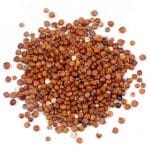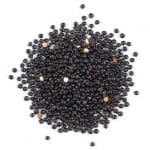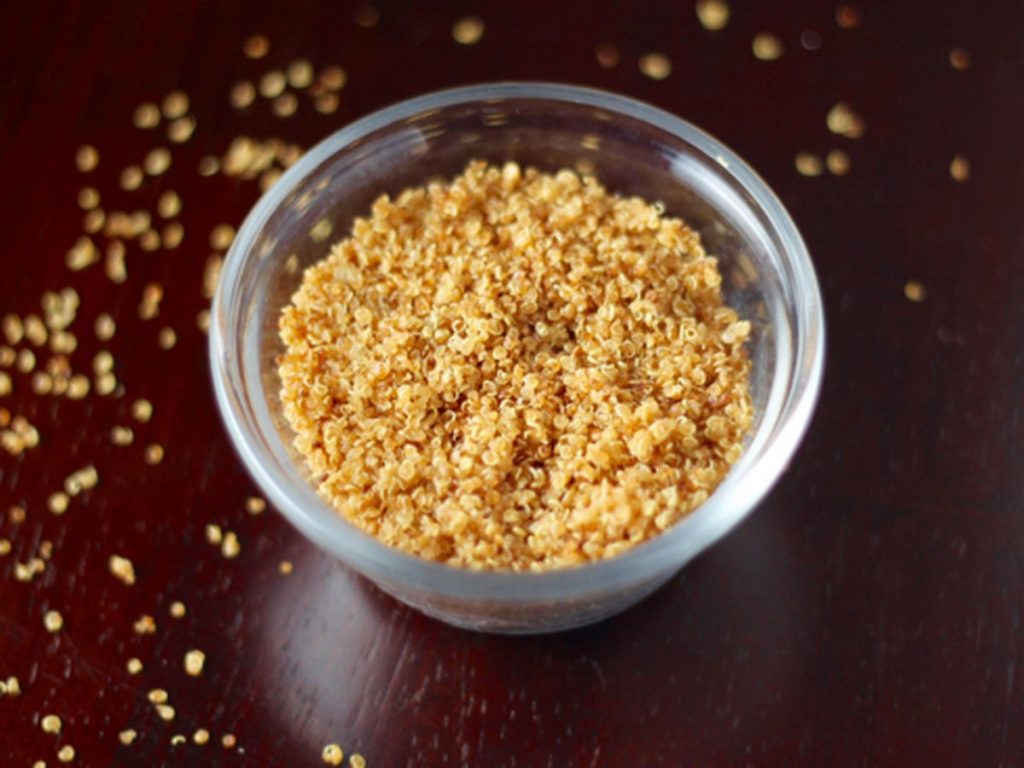Quinoa (Chenopodium quinoa) is an annual vegetable grown for its protein-packed seeds. The species is a flowering plant from the Amaranth family and originated somewhere in the mountainous regions of South America. Since ancient times, it has been cultivated and regarded as a superfood for the high concentrations of vitamins and minerals it stores in the seeds. The seeds have a mild taste and can be cooked like rice or ground and used as gluten-free flour. It is easy to grow and harvest quinoa from seeds in your home garden and is very productive. The tall plants give gold, pink and red seed heads, with each seed head producing enough to deliver around half a cup of seeds! Continue reading, and you’ll learn how to grow quinoa before you can get started with your own quinoa garden.
How To Plant Quinoa Seeds
You can plant quinoa either by direct seeding in the garden just after the last spring frost or by starting indoors. Gardeners living in short-season climates can benefit from starting the crop indoors since it gives sufficient time for seed heads to mature before harvest.
Seeds on Amazon
- 100 Chenopodium Quinoa Brilliant Rainbow Seeds for Growing
Prices pulled from the Amazon Product Advertising API on:
Product prices and availability are accurate as of the date/time indicated and are subject to change. Any price and availability information displayed on [relevant Amazon Site(s), as applicable] at the time of purchase will apply to the purchase of this product.
Growing Quinoa Indoors
Sow seeds in seedling trays or small pots 4 to 5 weeks before the last expected spring frost. Just spread them over light potting soil and cover them with a thin layer of soil. Mist it with water to moisten the soil. Place them under grow lights or next to a sunny window. Frequent misting will be needed to keep the soil consistently moist for faster germination.
Seeds will typically sprout within 4 to 5 days. Thin the seedlings to a single strongest one per small pot or cell of the seedling tray. Start fertilizing them with a diluted organic fertilizer once they’ve developed a few sets of leaves. Once the last spring frost has passed, harden off and transplant into the garden.
Quinoa Direct Seeding
Sow the seeds directly in the garden once the last spring frost has passed. The optimal temperature for quinoa seed germination is around 60°F. In warmer climates, gardeners often plant quinoa in late summers or early fall for harvesting in winters.
Choose a site with good sun exposure and good drainage and prepare it by amending with plenty of compost before planting the seeds. The ideal soil pH is between 6.0 to 7.5. Adding peat moss or organic material can help you optimize the pH.
Plant the seeds ¼ inch deep in the soil, spacing them 12 inches in rows that are also spaced around 12 inches apart. You can plant them closer than the specified spacing initially and thin them once the seedlings develop. Moisten the soil.
It will take around 4 to 5 days for the seeds to germinate. Keep the soil consistently moist and thin the seedlings to maintain a 12-inch spacing between the plants once they have a few leaves.
How To Grow Quinoa – Maintenance Tips

Quinoa is a low-maintenance plant that will bring huge harvests without much effort. Nevertheless, there are some growing specifications you should know about that will help your quinoa crop thrive and improve the harvest.
Light for Quinoa Growing
Quinoa plants should receive several hours of direct sunlight each day to develop optimally. However, in warm climates, providing some afternoon shade is ideal. If growing indoors, check our article for using indoor lighting.
How Much Water for Quinoa?
Young plants require regular watering to maintain consistently moist soil. At the same time, make sure the soil isn’t waterlogged at any time. Mature quinoa plants are relatively drought-tolerant, but they will perform better if you maintain a regular watering schedule. Water mature plants deeply each time the soil dries out slightly and stop watering by the end of summer as the seeds approach maturity.
Quinoa Fertilizer
When planted in fertile soil amended with plenty of organic matter, quinoa won’t need additional feeding during the season. For a stronger start, you can also incorporate a slow-release balanced organic fertilizer into the garden bed at the time of planting the seeds.
Quinoa Weeding
Quinoa develops slowly if it’s surrounded by weeds. Pull out any weeds that appear around the quinoa crop. Mulching can help keep weeds at bay and conserve moisture in the soil for healthy growth.
Harvesting Quinoa
Quinoa typically takes between 90 to 120 days to come to harvest. Wait until the leaves have fallen off and the seed heads remain on the plant before harvesting. On a day when the weather is dry, bend the seed heads into a bucket and strip them, so the seeds fall in the bucket. Sift the seeds to clear the debris and spread them out on a tray to dry them under the sun. You can also dry them indoors by placing them next to a heat source. Once properly dried, store it in an airtight jar in a cool, dry location. Stored in this way, quinoa can last for up to 6 months.
Is Quinoa Keto?

Quinoa is a healthier alternative to rice and flour. Yet, it is high on carbs and, consequently, isn’t suitable for the keto diet. Additionally, it also has a high glycemic index. A high GI suggests that quinoa takes longer to digest, causing a slow rise in blood sugar and insulin levels.
Can You Eat Quinoa Raw?
So you learned how to grow quinoa, so can you eat it straight from the garden? Not really. Quinoa is also eaten raw after being soaked and sprouted. However, some experts recommend cooking quinoa before consuming it. Cooking is undoubtedly a safer way to eat quinoa and brings more versatility to your meals. Nevertheless, if you still plan on consuming it uncooked, in sprout form, make sure you purchase untreated and unhulled seeds from a reliable retailer or grow your own. Quinoa seeds available at grocery stores are typically hulled and unsuitable for sprouting.
How to Eat Raw Quinoa –
To sprout raw quinoa seeds for consumption, rinse them and soak them for several hours. Next, drain the water, rinse the seeds and store them in a jar in a warm, dark location. Drain the water and rinse the seeds three times a day until you see green growth. As soon as sprouts emerge, they are ready for use. You can add them to sandwiches and stir-fries. Store the sprouts in the refrigerator and consume them within a few days.
Can Dogs Eat Quinoa?
Yes, dogs can eat quinoa. In fact, it’s nutritious for them and a healthier alternative to wheat and corn. Quinoa is also an ingredient in some dog foods. According to some, however, the chemical compound called saponin that quinoa plants naturally produce to repel insects is unhealthy for humans and animals. However, since saponin concentration in the plant is too small, it does not have any noticeable side effects on humans. If you’re concerned that your dog’s digestive system might be sensitive to the compound, wash and cook the seeds before offering it as a meal.
If this is the first time you are offering it to your dog, only offer it in small amounts and see how the dog responds before making it a part of its regular diet. Also, never offer your dog quinoa from your plate since seasonings you might have added to the recipe can be toxic to your furry friend.
What is Red Quinoa?

Red quinoa is a cultivar of the flowering plant Chenopodium quinoa and is distinguished for its violet seeds. The variety is also called Inca Red after its popularity among the Inca soldiers who believed that the red color of the seeds gave them strength for the battle. Just like any other quinoa, red quinoa is gluten-free and packed with nutrients. Raw red quinoa seeds are slightly flattened and hard. Once cooked, they swell up into tiny balls with a soft and chewy texture.
What is Black Quinoa?

Black quinoa is a cross between white quinoa and lamb’s quarter. Lamb’s quarter is an annual wild edible from the Amaranthaceae family. Black quinoa has a darker shade than the standard white quinoa seeds and is also crunchier and sweeter. It’s not as commonly available as red and white quinoa varieties. Just like other quinoa varieties, black quinoa is gluten-free and rich in protein, iron, vitamins, antioxidants, copper, and manganese.
Quinoa Recipes – Quinoa Crisps

Other than preparing quinoa like cereal, you can also turn it into a healthy snack – quinoa chips! They’re super easy to prepare and incredibly tasty to eat. Check out the recipe below to get started:
Quinoa Crisps Ingredients
- ¼ cup quinoa flour
- ½ cup brown rice flour
- ½ cup water
- ⅓ tsp salt
- 2 tbsp olive oil
- Sea salt, black pepper, and garlic powder for sprinkling
Directions
- Heat the oven to 300°F.
- Brush a baking tray with a thin layer of oil and set aside.
- Mix rice flour, quinoa flour, salt, water, and oil in a bowl into a smooth batter.
- Take out ½ tbsp batter onto the baking tray at 1-inch spacing for each cracker and smooth it out with a spoon into a 2-inch circle.
- Sprinkle the crackers with garlic powder, salt, and pepper.
- Bake for around half an hour or until light brown and crisp.
How to Grow Quinoa – Conclusion
Now that you know how to grow quinoa, create your healthy edible garden, and enjoy nutritious snacks every day! With just a little bit of effort, you can harvest enough to support a healthy lifestyle.








